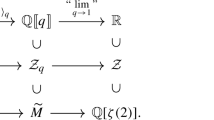Abstract
In this paper we explore five topics from the theory of partitions: (1) the Rademacher conjecture, (2) the Herschel-Cayley-Sylvester formulas, (3) the asymptotic expansions of E.M. Wright, (4) the asymptotics of mock theta function coefficients, (5) modular transformations of q-series.
Similar content being viewed by others
References
H.L. Alder, “Partition identities-from Euler to the present,” Amer. Math. Monthly 76 (1969), 733-746.
G.E. Andrews, “On the theorems ofWatson and Dragonette for Ramanujan's mock theta functions,” Amer. J. Math 88 (1966), 454-490.
G.E. Andrews, “Partition identities,” Advances in Math. 9 (1972), 10-51.
G.E. Andrews, The Theory of Partitions, Addison-Wesley, Reading 1976; reprinted, Cambridge University Press, Cambridge, 1984, 1998.
G.E. Andrews, “Mock theta functions,” Proc. Symp. in Pure Math 49 (1989), 283-298.
J. Arkin, “Researches on partitions,” Duke Math. J. 38 (1970), 403-409.
A.O.L. Atkin, “Proof of a conjecture of Ramanujan,” Glasgow Math. J. 8 (1967), 14-32.
P. Bateman and P. Erdös, “Monotonicity of partition functions,” Mathematika 3 (1956), 1-14.
R.J. Baxter, “A direct proof of Kim's identities,” J. Phys. A: Math. Gen. 31 (1998), 1105-1108.
B.C. Berndt, Ramanujan's notebooks, Part IV, Springer Verlag, New York, 1994.
B.C. Berndt, P.B. Bialek, and A.J. Yee, “Formulas of Ramanujan for the power series coefficients of certain quotients of eisenstein series,” Inter. Math. Res. Not. 21 (2002), 1077-1109.
B.C. Berndt and K. Ono, “Ramanujan's unpublished manuscript on the partition and tau functions with proofs and commentary,” (Andrews Festschrift, D. Foata, and G.-N. Han, eds.), Springer Verlag, Berlin, 2001, pp. 39-110.
A. Cayley, “Researches on the partition of numbers,” Phil. Trans. Royal Soc. 146 (1856), 127-140, (Reprinted: Coll. Math. Papers, 2 (1889), 235-249).
A. DeMorgan, “On a new form of difference equation,” Cambridge Math. J. 4 (1843), 87-90.
L. Dragonette, “Some asymptotic formulae for the mock theta series of Ramanujan,” Trans. Amer. Math. Soc. 72 (1952), 474-500.
L. Ehrenpreis, “Function theory for Rogers-Ramanujan-like partition identities,” Contemporary Math 143 (1993), 259-320.
J.W.L. Glaisher, “On the number of partitions of a number of partitions of a number into a given number of parts,” Quart. J. Pure and Appl. Math. 40 (1908), 57-143.
K. Glösel, “Ñber die Zerlegung der ganzen Zahlen,” Monatschefte Math. Phys. 7 (1896), 133-141.
H. Gupta, E.E. Gwyther, and J.C.P. Miller, Tables of Partitions, Royal Soc. Math.Tables, Cambridge University Press, Cambridge, 1958, Vol. 4.
G.H. Hardy and S. Ramanujan, “Asymptotic formulae in combinatory analysis,” Proc. London Math. Soc. 17(2) (1918), 75-115.
J.F.W. Herschel, “On circulating functions and on the integration of a class of equations of finite differences into which they enter as coefficients,” Phil. Trans. Royal Soc. London 108 (1818), 144-168.
A.E. Ingham, “A Tauberian theorem for partitions,” Annals of Math. 42 (1941), 1075-1090.
D. Kim, “Asymmetric XXZ chain at the antiferromagnetic transition: Spectra and partition functions,” J. Phys. A: Math. Gen. 30 (1996), 3817-3836.
R. McIntosh, “Some asymptotic formulae for q-hypergeometric series,” J. London Math. Soc. 51(2) (1995), 120-136.
P.A. MacMahon, Combinatory Analysis, Cambridge University Press, London, 1916,Vol. 2. reprinted Chelsea, New York, 1960.
E. Netto, Lehrbuch der Combinatorik 2nd edn., Teubner, Berlin, 1927; reprinted: Chelsea, New York, 1958.
J.L. Nicolas and A. Sárközy, “On the asymptotic behavior of general partition functions,” Ramanujan Journal 4 (2000), 29-39.
K. Ono, “On the parity of the partition function in arithmetic progressions,” J. für die r. und a. Math. 472 (1996), 1-16.
K. Ono, “Distribution of the partition function modulo m,” Annals of Math. 151 (2000), 293-307.
P. Paoli, Opuscula Analytica, Liburni, 1780, Opusc. II (Meditations Arith.), Section 1.
H. Rademacher, Lectures on Elementary Number Theory, Blaisdell, New York, 1964.
H. Rademacher, Topics in Analytic Number Theory, Springer, New York, 1973.
S. Ramanujan, Collected Papers, Cambridge University Press, London, 1927; reprinted: A.M.S. Chelsea, 2000 with new preface and extensive commentary by B. Berndt.
S. Ramanujan, The Lost Notebook and Other Unpublished Papers, Narosa, New Delhi, 1988.
L.B. Richmond, “A general asymptotic result for partitions,” Canadian J. Math. 27 (1975) 1083-1091.
K.F. Roth and G. Szekeres, “Some asymptotic formulae in the theory of partitions,” Quant. J. Math. Oxford Series 5(2) (1954), 241-259.
I. Schur, Ein Beitrag zur additiven Zahlentheorie und zur Theorie der Kettenbrüche, S.-B. Preuss. Akad. Wiss., Phys.-Math. Kl., 1926, 488-495.
J.J. Sylvester, “On subinvariants, i.e. semi-invariants to binary quantics of an unlimited order. With an excursus on rational fractions and partitions,” Amer. J. Math. 5 (1882), 79-136.
G. Szekeres, “An asymptotic formula in the theory of partitions, II,” Quart. J. Math. Oxford Series 2(2) (1951), 85-108.
G.N. Watson, “The final problem: An account of the mock theta functions,” J. London Math. Soc. 11 (1936), 55-80.
G.N. Watson, “Ramanujans Vermutung über Zerfälllungsanzahlen,” J. reine und angew. Math. 179 (1938), 97-128.
E.M. Wright, “Asymptotic partition formulae, I. plane partitions,” Quart. J. Math., Oxford Series 2 (1931), 177-189.
E.M. Wright, “Asymptotic partition formulae, II.Weighted partitions,” Proc. London Math. Soc. 36(2) (1932), 117-141.
E.M. Wright, “Asymptotic partitions formulae, III. Partitions into k-th powers,” Acta Math. 63 (1934), 143-191.
Author information
Authors and Affiliations
Rights and permissions
About this article
Cite this article
Andrews, G.E. Partitions: At the Interface of q-Series and Modular Forms. The Ramanujan Journal 7, 385–400 (2003). https://doi.org/10.1023/A:1026224002193
Issue Date:
DOI: https://doi.org/10.1023/A:1026224002193




